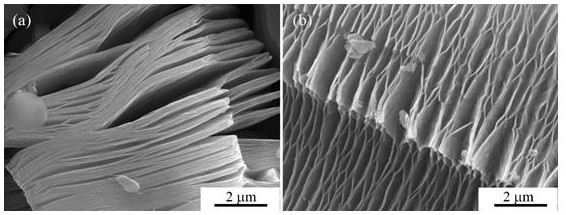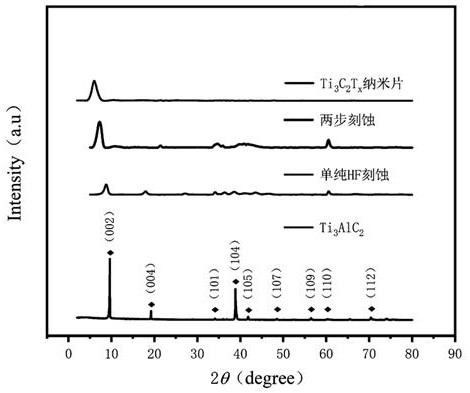Fabrication of few-layer ti with high etch rate and high lift-off rate based on secondary etching method 3 c 2 t x material method
A technology of secondary etching and etching rate, which is applied in the field of 2D nanomaterials, can solve the problems of incomplete etching, low stripping rate, long etching cycle, etc., and achieve long time period, low production efficiency and high production efficiency Effect
- Summary
- Abstract
- Description
- Claims
- Application Information
AI Technical Summary
Problems solved by technology
Method used
Image
Examples
Embodiment 1
[0052] Preparation of few-layer Ti with high etching rate and high stripping rate based on secondary etching method 3 C 2 T x The method of the material includes the following steps:
[0053] (1) Weigh 1.0g Ti 3 AlC 2 The powder was slowly added to 12ml of HF aqueous solution with a mass fraction of 40%, and the mixed solution was covered and placed in a fume hood, while stirring in a magnetic stirrer and heating up to 35°C, the speed of the magnetic stirrer was 500rpm, and the magnetic stirring was 4h. Then, centrifuge at 4000rpm for 10min, wash with water for several times until neutral, and obtain a pre-etched product;
[0054] (2) Use a graduated cylinder to measure 10 ml of HCl with a concentration of 3 mol / L, and weigh 1.6 g of LiF, slowly add LiF to the HCl solution, and place the mixed solution in a magnetic stirrer at room temperature for 15 minutes and magnetic stirring. The rotating speed of the device is 300rpm, and the mixed solution is used as a secondary et...
Embodiment 2
[0060] Preparation of few-layer Ti with high etching rate and high stripping rate based on secondary etching method 3 C 2 T x The method of the material includes the following steps:
[0061] Except that the concentration of HCl in (2) is 6mol / L;
[0062] (3) medium magnetic stirring for 6h;
[0063] The rest are the same as in Example 1.
[0064] After drying the upper layer suspension, 800 mg of few-layer Ti was obtained 3 C 2 T x , calculate Ti according to the mass 3 C 2 T x Etching rate of 96%, few layers of Ti 3 C 2 T x The peeling rate is 80%.
[0065] Figure 4 ( Figure 4 (a) and Figure 4 (b)) Few-layer Ti for the product prepared in Example 2 of the present invention 3 C 2 T x The TEM image of the material, it can be seen from the TEM results that the few-layer Ti prepared in Example 2 3 C 2 T x The sample still has an ultra-thin two-dimensional layered structure, and the nanosheets have a relatively large lateral size, indicating that the few-...
Embodiment 3
[0067] Preparation of few-layer Ti with high etching rate and high stripping rate based on secondary etching method 3 C 2 T x The method of the material includes the following steps:
[0068] Except that the concentration of HCl in (2) is 12mol / L;
[0069] (3) medium magnetic stirring for 6h;
[0070] The rest are the same as in Example 1.
[0071] After drying the upper suspension, 850 mg of few-layer Ti were obtained 3 C 2 T x , calculate Ti according to the mass 3 C 2 T x Etching rate of 95%, few layers of Ti 3 C 2 T x The peeling rate was 85%.
PUM
| Property | Measurement | Unit |
|---|---|---|
| quality score | aaaaa | aaaaa |
Abstract
Description
Claims
Application Information
 Login to View More
Login to View More - R&D
- Intellectual Property
- Life Sciences
- Materials
- Tech Scout
- Unparalleled Data Quality
- Higher Quality Content
- 60% Fewer Hallucinations
Browse by: Latest US Patents, China's latest patents, Technical Efficacy Thesaurus, Application Domain, Technology Topic, Popular Technical Reports.
© 2025 PatSnap. All rights reserved.Legal|Privacy policy|Modern Slavery Act Transparency Statement|Sitemap|About US| Contact US: help@patsnap.com



